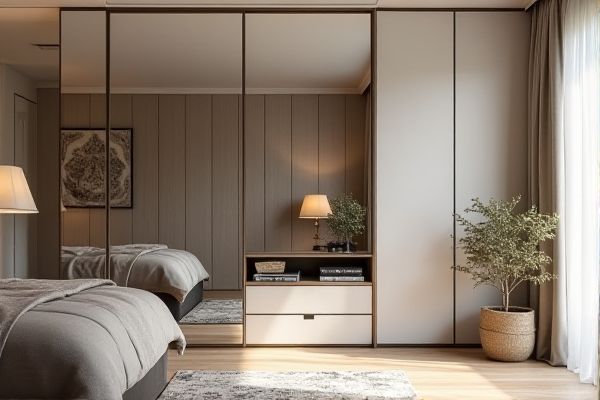
Freestanding mirrors offer flexibility in placement and style, easily moved to suit changing room layouts, while built-in mirrors provide a sleek, space-saving solution integrated directly into closets for a seamless look. Explore the benefits and drawbacks of both options to determine which mirror best enhances your space and fits your lifestyle needs.
Table of Comparison
| Feature | Freestanding Mirror | Built-in Mirror (Closet) |
|---|---|---|
| Installation | No installation required; portable and movable. | Requires professional installation; fixed in place. |
| Space Usage | Consumes additional floor space. | Space-saving and integrated into the closet design. |
| Design Flexibility | Available in various styles and sizes; easy to change. | Customizable to match closet aesthetics; permanent fixture. |
| Cost | Generally lower initial cost. | Higher cost due to installation and customization. |
| Durability | Prone to tipping or damage if not secured. | More stable and durable as part of closet structure. |
| Maintenance | Easy to clean and move for maintenance. | May require more effort to clean due to integration. |
| Functionality | Ideal for flexible use in different rooms. | Optimized for dressing area efficiency. |
Introduction to Mirror Types: Freestanding vs Built-In
Freestanding mirrors offer flexibility in placement and style, making them ideal for renters or those who frequently redecorate, while built-in closet mirrors provide a seamless, space-saving solution integrated directly into your storage system. Your choice depends on room layout, design preferences, and whether you prioritize portability or a permanent fixture that enhances closet accessibility. Both types serve essential functions in daily grooming and space aesthetics but differ significantly in installation and versatility.
Design and Aesthetic Appeal
Freestanding mirrors offer versatile design options with a range of frame styles and sizes that can easily be repositioned to complement your room's aesthetic. Built-in mirrors in closets provide a sleek, integrated look that maximizes space and creates a seamless, modern appearance. Your choice depends on whether you prioritize flexibility and statement pieces or a minimalist, cohesive design.
Space Considerations and Room Layout
Freestanding mirrors offer versatile placement options, allowing you to easily move and adjust them based on changing room layouts, making them ideal for flexible spaces. Built-in closet mirrors save floor space and create a streamlined, integrated look, which is perfect for smaller rooms or minimalist designs. You can enhance your room's functionality by choosing freestanding mirrors for adaptability or built-in mirrors for maximizing available space and maintaining a clean aesthetic.
Installation and Flexibility
Freestanding mirrors require no permanent installation, allowing easy relocation and versatility in room layout, making them ideal for renters or frequently changing spaces. Built-in mirrors in closets are fixed installations that save floor space and integrate seamlessly with cabinetry, but they lack flexibility once installed and require professional mounting. Choosing between them depends on the need for portability versus a permanent, space-efficient design.
Functionality and Versatility
Freestanding mirrors offer exceptional flexibility, allowing users to easily reposition them across different rooms or adjust angles for full-body viewing, making them ideal for dynamic spaces. Built-in closet mirrors provide a streamlined, permanent solution that maximizes space efficiency and integrates seamlessly with storage, enhancing daily dressing routines. While freestanding mirrors emphasize versatility, built-in mirrors excel in enhancing closet organization and consistent accessibility.
Cost Comparison: Freestanding vs Built-In Mirrors
Freestanding mirrors typically come at a lower upfront cost, with prices ranging from $50 to $300 depending on size and design, offering budget-friendly flexibility for Your space. Built-in mirrors, integrated into closet doors or walls, often require professional installation, driving costs between $300 and $1,000 or more based on materials and labor complexity. Considering long-term value, built-in mirrors add to home customization and resale appeal, whereas freestanding options provide portability without permanent commitment.
Maintenance and Durability
Freestanding mirrors require regular cleaning and careful handling to prevent scratches or damage to their frames, as they are more exposed and prone to tipping over. Built-in closet mirrors are typically more durable due to their fixed installation, reducing the risk of damage and making maintenance easier since they accumulate less dust and are less likely to be knocked over. Your choice between these mirror types should consider the ease of upkeep and long-term durability based on your space and lifestyle.
Safety and Stability Factors
Freestanding mirrors offer easy mobility but may lack the stability of built-in mirrors, increasing the risk of tipping if not properly secured. Built-in closet mirrors are typically anchored to the wall or door frame, providing enhanced safety and reducing the chance of accidents, especially in households with children or pets. Ensuring your mirror is installed with appropriate hardware can significantly improve stability regardless of the type you choose.
Customization and Personalization Options
Freestanding mirrors offer greater customization and personalization options, allowing selection of frame styles, sizes, and finishes to complement various interior designs. Built-in closet mirrors integrate seamlessly into cabinetry, providing a sleek, space-saving solution customizable primarily through panel materials, colors, and hardware choices. Both options enable tailored aesthetics, but freestanding mirrors grant more flexibility for repositioning and style updates over time.
Choosing the Right Mirror for Your Space
Freestanding mirrors offer versatility and mobility, making them ideal for rooms with flexible layouts or limited wall space, while built-in mirrors integrated into closets maximize space by combining storage and reflection functionality. Choosing between the two depends on room size, design aesthetics, and usage needs; freestanding mirrors often suit larger, open areas, whereas built-in mirrors optimize compact spaces with streamlined organization. Consider lighting conditions and room flow when selecting the mirror type to enhance both utility and visual appeal.
 homyna.com
homyna.com